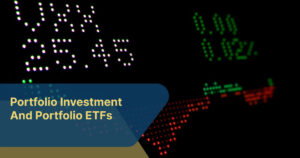
- A portfolio is defined as a list of all investments made.
- Even a few portfolio ETFs are enough to change the risk profile significantly.
- A conservative EFT portfolio will try to reduce the risk for the investor.
- Bond ETFs work the same way as their equity-based counterparts.
- A leveraged EFT strategy can provide extraordinary results and higher payouts.
- It is possible to build and construct your portfolio to be safer and riskier by simply making a few changes.
Anyone who invests their money will, sooner or later, have to deal with their portfolio investment. A portfolio is defined as a list of all investments made. You will still have a portfolio even if you have acquired your assets without a defined strategy and deliberate weighting. However, doing extensive investment research to get a balanced portfolio that considers your security needs, risk appetite, and overall goals makes more sense.
This is where ETFs can do a good job in this respect. Even a few portfolio ETFs are enough to change the risk profile significantly in either direction! This article will discuss both options; how to increase security by a portfolio investment in ETFs and which portfolio EFT stands for more risk and return.
A Conservative EFT Portfolio
A conservative EFT portfolio will try to reduce the risk for the investor by focusing on assets with a fixed return or minimal market risk. While most people only consider stocks, when referring to EFTs, it is possible to invest in bonds when using them.
Bond ETF
Bond ETFs work the same way as their equity-based siblings, constructed within fixed parameters, such as country, risk rating, maturity, and type of issuer. An index is created that the ETF must follow. As a result, choosing a bond ETF allows those with little investment research to give direction to their portfolio investment.
What Are Bonds?
Bonds have the advantage of taking care of a completely different, often neglected, asset class. While many people like fixed-income investments, these are commonly arranged through a bank. Bond-ETFs allows you to skip this middleman and directly participate in the bond markets.
With a bond, you act as a creditor. With a bond, you act as a creditor. When you purchase a bond, the issuer gives you credit over a fixed term and credit rate. With valid bonds, you will receive the agreed interest as a rate, and the lent sum is refunded at the end of the term. The biggest advantage is the great predictability of income and risk. If the price of a bond fluctuates, you can always hold the bond until the end of the term.
The most well-known are government bonds, which states issue to finance their debts. Considered particularly safe. They are extremely popular for a conservative EFT portfolio. However, corporate bonds issued by companies can often offer a higher return.
Beware Of Inflation
The most significant disadvantage of bond ETFs and bonds is their vulnerability to inflation. Unlike tangible assets, such as stocks, they are held exclusively as money assets. Therefore, if the money loses value, the overall return on the bond is reduced. Focusing on bonds with a short maturity can reduce the risk of inflation, but it is never entirely removed.
Stocks And Stock ETFs
Stocks and stock EFTs are not immune from inflation. However, if you want your portfolio to be inflation-restricted, it is possible through a wise selection. Large, established companies with proven business success are less affected by fluctuations, making it preferential to opt for value stocks over growth stocks.
Dividend ETF
Dividend ETFs deserve special attention, primarily invested in stocks that pay an above-average dividend. They are almost always large, well-established companies with solid cash flow.
In addition, their high dividend payout usually attract investors looking for long-term investment options. Their long-term nature reduces the trading frequency of the shares and stabilizes the price. With a Dividend ETF, it is possible to supplement your portfolio with a selection of defensive yet high-yielding stocks.
ACC Vs. DIS
It is crucial to be aware that not all dividend ETFs handle the payments they receive the same. While most dividend EFTs will distribute the money to investors (DIS), some ETFs reinvest the profits to increase their value (ACC). The investor’s goals and interests are pivotal in choosing the best option.
Monthly Dividend ETF
Receiving monthly dividends is often a popular investment option when building your EFT portfolio. While it is important to be aware, stock and bond EFTs do not pay monthly. Instead, they commonly pay out every quarter. Since the month’s payout can differ, it is achievable for the dividends to be distributed and achieve the goal of a monthly dividend with just three ETFs.
While monthly dividends may be possible, they should not be the main focus of your portfolio. Instead, your focus should be diversity and acceptable returns.
More Risk And More Opportunity
Conversely, it may be necessary to increase your investment risks for potentially increased gains. Resulting in you taking more risk and higher volatility for your assets. A leveraged EFT strategy can provide extraordinary results and higher payouts.
Leveraged EFT Strategy
Unlike other EFTs, leveraged EFTs invest in the underlying stocks and derivatives. These derivatives include options and, commonly, credit-financed leverage. This variation makes it possible for the EFT to achieve above-average profits when prices rise. Often doubling or tripling the standard expected price gains. However, these gains come with you taking an increased risk, as any loss also is more heavily weighted. While any price slump brings negative implications, you risk losing it all in this type of investment.
A Long-Term Leveraged ETF Strategy?
If you want to execute your EFT strategy long-term, such as in a long bull market, you need to ensure you are not overdoing it with your leverage. Proceeding with low leverage protects you and allows you to withstand losses easier. In contrast, a high leverage loss carries a higher risk and would cause the entire investment to be lost even with temporary short drops. Of Course, you should be careful and always keep an eye on your portfolio.
Conclusion
As highlighted, it is possible to build and construct your portfolio to be safer and riskier by simply making a few changes and completing investment research. However, you must consider your attitude to risk, the type of investor you are, and the goals your want to achieve. Only with this considered can you make the right selection.

